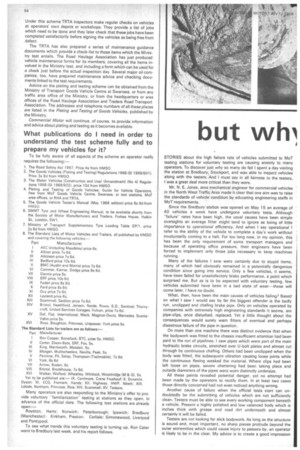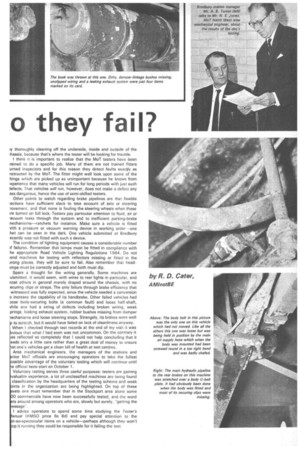but will
Page 56

Page 57

If you've noticed an error in this article please click here to report it so we can fix it.
o they fail?
STORIES about the high failure rate of vehicles submitted to MoT testing stations for voluntary testing are causing anxiety to many operators. To discover just why so many do fail I spent a day visiting the station at Bredbury, Stockport, and was able to inspect vehicles along with the testers. And I must say in all fairness to the testers. I was a great deal more critical than they were.
Mr. N. E. Jones, area mechanical engineer for commercial vehicles in the North West Traffic Area made it clear that one aim was to raise the standards of vehicle condition by educating engineering staffs in MoT requirements.
Since the Bredbury station was opened on May 15 an average of 40 vehicles a week have undergone voluntary tests. Although "failure" rates have been high, the usual causes have been simple oversights an average fitter might tend to ignore as being of little importance to operational efficiency. And when I say operational I refer to the ability of the vehicle to complete a day's work without involuntarily coming to a halt. For too long now, in my opinion, this has been the only requirement of some transport managers and because of operating office pressure, their engineers have been forced to implement only those jobs necessary to keep machines running.
Many of the failures I saw were certainly due to stupid items, many of which had obviously remained in a potentially dangerous condition since going into service. Only a few vehicles, it seems, have been failed for unsatisfactory brake performance, a point which surprised me. But as is to be expected with voluntary testing, few vehicles submitted have been in a bad state of wear—these will come later, I have no doubt.
What, then, have been the main causes of vehicles failing? Based on what I saw I would say by far the biggest offender is the badly run, unclipped and chafing brake pipe. Only on vehicles operated by companies with extremely high engineering standards it seems, are pipe-clips, once disturbed, replaced. Yet a little thought about the consequences would surely warn fitters of eventual and perhaps disastrous failure of the pipe in question.
On more than one machine there was distinct evidence that when the bodywork was fitted to the chassis insufficient attention had been paid to the run of pipelines. I saw pipes which were part of the main hydraulic brake circuits, stretched over U-bolt plates and almost cut through by continuous chafing. Others had been unclipped when the body was fitted, the subsequent vibration causing loose joints while the continuous flexing weaked the material. Where clips had been left loose on pipes, severe chattering had been taking place and outside diameters of the pipes were worn distinctly undersize.
All these points revealed potential danger, yet no attempt had been made by the operators to rectify them. In at least two cases those directly concerned had not even noticed anything wrong.
Another cause of failure when the official tests start can undoubtedly be the submitting of vehicles which are not sufficiently clean. Testers must be able to see every working component beneath a vehicle. Present a highly polished and low valanced body which is inches thick with grease and road dirt underneath and almost certainly it will be failed.
Testers are not looking for slick bodywork. As long as the structure is sound and, most important, no sharp pieces protrude beyond the outer extremities which could cause injury to passers-by, an operator is likely to be in the clear. My advice is to create a good impression iy thoroughly cleaning off the underside, inside and outside of the ;hassis, because that's where the tester will be looking for trouble.
I think it is important to realize that the MoT testers have been rained to do a specific job. Many of them are not trained fitters urned inspectors and for this reason they detect faults exactly as nstructed by the MoT. The fitter might well look upon some of the hinge which are picked up as unimportant because he knows from !xperience that many vehicles will run for long periods with just such lefects. That vehicles will run, however, does not make a defect any ass dangerous, hence the use of semi-skilled testers.
Other points to watch regarding brake pipelines are that flexible ections have sufficient slack to take account of axle or steering iovement, and that none is fouling the steering wheels when these ire turned on full lock. Testers pay particular attention to fluid, air or ,acuum leaks through the system and to inefficient parking-brake nechanisms—ratchets for instance. Make sure a vehicle is fitted vith a pressure or vacuum warning device M working order -one hat can be seen in the dark. One vehicle submitted at Bredbury ecently was not fitted with such a device.
The condition of lighting equipment causes a considerable number 4 failures. Remember that lamps must be fitted in compliance with he appropriate Road Vehicle Lighting Regulations 1964. Do not ;end machines for testing with reflectors missing or fitted in the acing places, they will be sure to fail. Also remember that headimps must be correctly adjusted and both must dip.
Spare a thought for the wiring generally. Some machines are ubmitted, it would seem, with wires to rear lights in particular, and nest others in general merely draped around the chassis, with no ecuring clips or straps. The only failure through brake efficiency that witnessed was fully expected, since the vehicle needed a conversion
o increase the capability of its handbrake. Other failed vehicles had dose body-securing bolts (a common fault) and loose half-shaft, vhile one had a string of defects including broken wiring, weak ,prings, leaking exhaust system, rubber bushes missing from damper nechanisrns and loose steering stops. Strangely, its brakes were well p to scratch, but it would have failed on lack of cleanliness anyway. When I checked through test records at the end of my visit it was vious that what I had seen was not uncommon. On the contrary it as reflected so completely that I could not help concluding that it eeds only a little care rather than 3 great deal of money to ensure at one's vehicles get a clean bill of health at test centres.
Area mechanical engineers, the managers of the stations and nior MoT officials are encouraging operators to take the fullest ossible advantage of the voluntary testing which will continue until e official tests start on October 1.
Voluntary testing serves three useful purposes: testers are gaining valuable experience, a lot of unclassified machines are being found classification by the headquarters of the testing scheme and weak nts in the organization are being highlighted. On top of these ets one must remember that in the Stockport area alone some 0 commercials have now been successfully tested, and the word s around among operators who are, slowly but surely, "getting the essage".
I advise operators to spend some time studying the Tester's anual (HMSO price 6s 6d) and pay special attention to the .t-so-spectacular items on a vehicle—perhaps although they won't op it running they could be responsible for it failing the test.












































































































